The Misericords of St. Stephen's Church, Sneinton
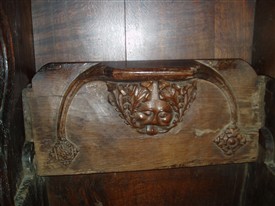
The Green Man
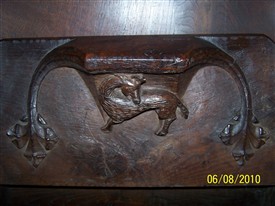
The Goat?
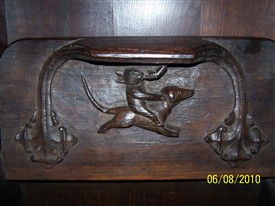
Fox riding a dog
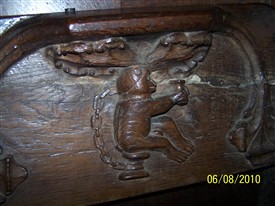
The bear or ape?
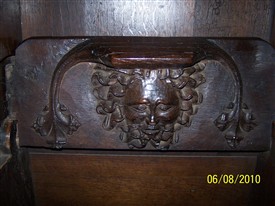
The Sun
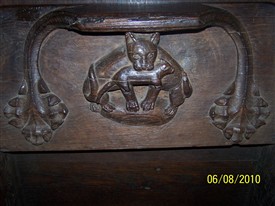
The Lion and its cub or lamb?
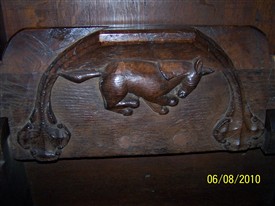
The Unicorn
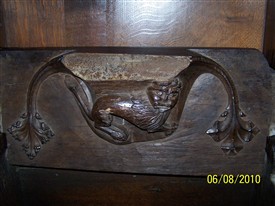
The Lion
By R B Parish
In the 19th century imposing grandeur of St Stephen’s Church, Sneinton, one may be surprised to find some of the finest medieval misericords in the county in this ‘modern church’.
What are Misericords?
Misericords were small wooden shelves underneath the chair of a choir. They were established in churches to provide some comfort for a person who would be standing for long periods of prayer. As this would often held the infirm, the term misericord deriving from ‘act of mercy’. Like many other features in the church, the misericord became a subject of highly carved images which had an inner symbolism.
Why St Stephens?
They were installed in St Mary’s Church, Nottingham when they were removed in 1848 when the church was being restored. It is said that the organist, Mr Wilcockson, is said to have purchased them for 10 shillings and they were placed in the church in 1909. Two stories are recorded regarding how they were found; one suggests they were on sale in Sneinton Market, the other that they were in a pile of rubbish at St. Mary’s church. They date from the late 15th or early 16th century.
What do the carvings mean?
The images on the misericords are as follows:
A fox riding a hound and blowing a hunting horn, in some accounts said to be a rat. This may relate to the deceitful nature of the fox which would mean he would be a symbol of the Devil, the image of him riding a dog in a hunt emphasised the carnal nature of hunting perhaps in a satirical fashion.
A goat, possibly a horse. If it is a goat, it was often shown as a symbol of Jesus, as he was known to be able to see far distances from the mountain and tell whether men approaching were harmless or hunters. Thus this was a message to emphasise the far seeing nature of God and ability to see the deceit of the Devil and the betrayal of Judas.
A chained ape seated on a stool to which the chain is anchored. He holds in his outstretched hands holds a flagon and above him are the spreading branches of a tree. This has been elsewhere called a monkey but I feel it is on reflection a bear. As such it would make sense both being something medieval people would be familiar with in its streets and possibly the symbolism. The bear is often thought to be the Devil and as such, holding a flagon of alcohol possibly suggests how the Devil would tempt man to undesirable practices.
The most familiar symbol, even to the layman, is the Jack in the Green or Green man, in this case with formal elaborate flower pattern. This was of course despite the view, rightly or wrongly, that his presence is a leftover from pre-Christian times, in the Christian idea it represented, the spring, and as such the rebirth and resurrection.
There is a similar human head with a curled head and hair, possibly representing the Sun and thus relating to rebirth over the four seasons, the ever turning year.
There appear to be two lions: a bi-corporate (two bodies) lion holding a lamb in its jaws (often described as a cat with a rat in its jaws) and another passant garden to right. The lion is one of the most frequently seen in churches. His symbolism is said to be four fold. Firstly, that he is the Lion of Judah – a symbol of Christ. Secondly, that legend recalled that the lion sleeps with its eyes open and relates to the wakefulness of Christ as noted in Psalm cxxxi “behold, He that keepeth Israel shall neither slumber nor sleep.”. Thirdly, that his distinctive bushy tail he was able to conceal his tracks and so avoided the hunter, as did Jesus conceal his Godhead to all but those who sought Him correctly. Fourthly, that it represented the resurrection. This is related to the story of the lioness who gave birth to dead cubs, which so upset the male that he would howl for days and on the third day his breathe brought them back to life. This of course has parallels to Father causing his only Son to rise again. This probably explains the first lion described and that rather than a lamb it is a cub.
A unicorn with a shaggy coat, with head turned backwards. The unicorn was a popular symbol for Jesus, but is also seen as a symbol of female chastity and in the case of its location may relate to the Virgin Mary.
The misericords of St. Stephens give a real insite into the medieval mind and it is thankful they were preserved.
References:
Collins, A.H., (1913) Symbolism of Animals and birds represented in English church architecture. New York.